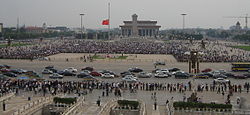Half-staff
Half-staff or half-mast describes a flag being displayed at halfway up a flagpole or a ship's mast. This is done in many countries as a symbol of respect, mourning, or distress, or a form of honor, often with a moment of silence.
The flag does not always have to be flown at exactly the half-way point, sometimes it is acceptable to have the "half-mast" flag at slightly lower or slightly higher than the middle of the flagpole or mast. Originally, "half-staff" meant that the flag had to be flown one flag-width from the top to allow for the "invisible flag of mourning" to be at the top.[1]
Half-staff Media
The Finnish flag flying at half-mast after the 2011 Norway attacks
The American flag flying at half-mast in Buchenwald, Thuringia, Nazi Germany, on 19 April 1945 after the death of US President Franklin Roosevelt
The Australian White Ensign flying at half-mast. In accordance with British tradition, the flag is flying only one flag's width below the top of the pole.
The Brazilian flag flying at half-mast beside the Mercosul flag in front of the National Congress of Brazil in memory of the victims of the Chapecoense crash on 29 November 2016
The flag of Canada, the flag of Québec, and the flag of the Royal Canadian Sea Cadets are half-masted on board Bagotville Cadet Summer Training Centre, following the train derailment and explosion in Lac Mégantic, Québec.
The flag of Canada at half-mast outside the Joseph Shepard Building in Toronto, following the death of Prince Philip, Duke of Edinburgh, 2021
Chinese flag at half-mast as a sign of mourning for the victims of the 2008 Sichuan earthquake
Cuban flag at half-mast for the state funeral of former leader Fidel Castro, 2016
Black ribbons indicate mourning on banners that cannot be lowered to half-mast.
References
- ↑ Franklyn, Julian, Shield and Crest: An Account of the Art and Science of Heraldry (London: MacGibbon & Kee, 1961), 176
Other websites
![]() Media related to Flags at half staff at Wikimedia Commons
Media related to Flags at half staff at Wikimedia Commons










